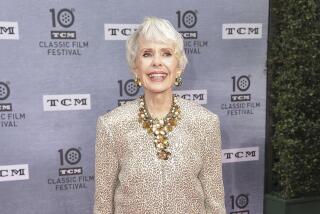Classic Hollywood: Remembering Gloria Grahame before ‘Film Stars Don’t Die in Liverpool’
For film noir buffs, Gloria Grahame was a goddess of the genre, starring in such films as Nicholas Ray’s 1950 “In a Lonely Place” and Fritz Lang’s 1953 “The Big Heat,” in which her face was on the losing end of a thrown pot of boiling water.
She could make the most out of a small scene — winning the supporting actress Oscar for 1952’s “The Bad and the Beautiful” (she’s on screen for 9 minutes, 32 seconds). And musical fans know her as Ado Annie in 1955’s “Oklahoma!” the girl “who can’t say no.”
But her personal life got in the way of superstardom. Married four times, she endured custody battles and saw her career practically disappear after she married Anthony Ray, her former stepson from her marriage to Ray. She was 36 and he was 23.
In the new drama “Film Stars Don’t Die in Liverpool,” which opens Friday, Annette Bening plays Grahame in her 50s, battling a resurgence of cancer while working in TV, film and theater and England and finding love with up-and-coming young British actor Peter Turner (Jamie Bell), nearly 30 years her junior. Turner’s book of the same name is the basis for the film.
We talked with some of those who acted with her and knew her about Grahame’s life and career.
Author Peter Turner
Turner quit acting after Grahame died of cancer in 1981 at the age of 57. “I didn’t have the taste for it or the stomach anymore,” he said. It took him several years to process her death before he began writing his book about her.
“Gloria never told me about her illness,” he said. “It was a huge blow.”
Despite their age difference, Turner always thought of her as a “young girl. Love is always young, isn’t it? It wasn’t a May to December [romance]. Our connection was we became friends, then it became deeper, more romantic.”
“She was articulate and intelligent. There was so much there. The privilege to spend 3½ years on her journey together was kind of wonderful.
“She was just so real and ahead of her time.”
Actress Susan Blakely
Blakely loved Grahame in “Oklahoma!” so she was excited when Grahame was cast as her mother in the 1976 ABC miniseries “Rich Man, Poor Man.” Or, as Blakely puts it, “I was dying.”
Though Grahame was professional, Blakely said, the veteran actress wasn’t very friendly. “I remember thinking because I was right out of all my acting classes, she was being very Method because the mother and daughter didn’t get along in ‘Rich Man, Poor Man.’ I thought she was being unapproachable” on purpose.
Blakely never found out if Grahame was getting her Method acting on. “But I thought she was a wonderful actress. I loved what she did. She was so good at playing somebody who was not wealthy, from the wrong side of the tracks.”
Filmmaker Joan Micklin Silver
Silver was looking for an actress to play the eccentric, crazy, laxative overdosing mother of a civil servant (John Heard) in 1979’s “Chilly Scenes of Winter.” And she found Grahame via the old “Million Dollar Movie” series that aired on TV in New York.
“I had three wonderful producers who were three young actors,” noted Silver. “We all called each other the next day because we had all seen in ‘In a Lonely Place.’’’
Silver acknowledged she hadn’t been familiar with Grahame before seeing the classic noir. “I just felt it was important to have a distinctive, interesting character in that part. I don’t know how we could have done better.”
Grahame was extremely easy to work with on the set. “We only had one conflict,” Silver recalled. “In the movie, she talks about the fact that her husband died when he was 39. He had a heart attack and died. Then the next line is, ‘I’m 57 and I’m not dead yet.’ She refused to say it because she was not 57. I said, ‘I know, but this isn’t about you. It’s about the character. The character’s talking about her age.’’’
But Grahame wouldn’t do it. She didn’t want people to think she was that old. “I changed it to ‘I’m 53 and I’m not dead yet.’ And she said it.
“She was one of a kind.”
Actress Terry Moore
Terry Moore had to hold back tears when she thought of Grahame, who played her trollop of a stepmother in 1953’s “Man on a Tightrope,” a drama set in a Czech circus which was shot in Germany in 1952.
“We bonded,” said Moore. “I don’t know of any woman in my life I loved more than I did Gloria.”
The actress didn’t do anything “she didn’t want to do,” said Moore.
Moore remembered a pivotal scene when Grahame learns her husband (Fredric March) has died. Director Elia Kazan wanted the actress to exit her trailer crying. But Grahame refused to cry take after take. Then Kazan talked to her.
“The next take, she comes out and is crying like you cannot believe,” Moore said, laughing. “The tears are streaming down her face.”
Kazan knew exactly what buttons to push. He told Grahame that Moore was “better in the movie” than she was.
Producer Cecilia DeMille Presley
Presley and her brother Joe Harper were raised by their grandfather, the legendary director Cecil B. DeMille. Both have fond memories of Grahame while on the set of their grandfather’s circus epic, the 1952 best picture winner “The Greatest Show on Earth.”
“Everybody fell in love with her,” said DeMille Presley, who is a producer and trustee of the DeMille Foundation.
DeMille Presley also remembers Grahame as a real trouper who was fearless playing a woman who worked with elephants.
“She worked with an elephant named Minyak,” said DeMille Presley. “She didn’t mind when the elephant put his foot on her face.”
Her grandfather would always present a silver coin to a performer who “did something quite amazing or brave or wonderful,” said DeMille Presley. “He gave her one of those coins for doing what she did because she was so damn brave.”
Harper, who is president and CEO of the Del Mar Thoroughbred Club, was just 7 when he was on the set.
He recalls her standing close to him before a scene. “She just looked down at me and said ‘Hey, sugar.’ Somehow or another that just made an impression on me, I guess. I think that was the first time I felt a little different!”
“She was very, very sexy,” added Harper “I just hung around [her] until she smiled at me. She put a big stamp on my memory.”
Veteran publicist Alan Eichler
Eichler met Grahame 40 years ago when he and the late writer/lyricist Tom Eyen (“Dreamgirls”) were watching “The Milliken Breakfast Show,” an annual industrial show at the Waldorf-Astoria. One of Grahame’s best friends brought her over to meet them.
“She was blonde and very pretty and kind of tiny. You know in the movies she looks big for some reason. She was a totally different personality than what you see on the screen. And we all kept laughing a lot. She was giddy. She was so happy. I think she was happy in New York.”
His brother, longtime stage manager Larry Eichler, lived at the Manhattan Plaza where Grahame kept an apartment for the last years of her life.
“He used he tell me about Gloria,” said Eichler. “She was always friendly and talked to people.”
And she made such an impression on her neighbors that after she died, said Eichler, the recreation/community room at the complex was dedicated to Grahame. “Her portrait hangs there,” he said. “When my brother passed away in 2005, we held his memorial there.”
More to Read
Only good movies
Get the Indie Focus newsletter, Mark Olsen's weekly guide to the world of cinema.
You may occasionally receive promotional content from the Los Angeles Times.







